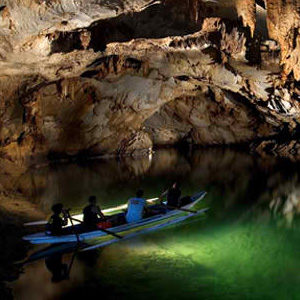
MANILA — The Puerto Princesa Underground River (PPUR) in Palawan now belongs to the “provisional” list of the world’s new seven wonders.
The New7Wonders Foundation, who initiated the search, has announced November 12 the poll’s provisional results.
Aside from the Puerto Princesa Underground River, the other world’s new natural wonders are Brazil’s Amazon, Vietnam’s Halong Bay, Argentina’s Iguazu Falls, South Korea’s Jeju Island, Indonesia’s Komodo Island and South Africa’s Table Mountain.
Bernard Weber, Founder-President of New7Wonders, announced the results from the New7Wonders headquarters in Zurich, Switzerland. A video of the announcement was posted at its website, http://world.n7w.com/.
According to the foundation, it’s possible that there will be changes between the above provisional winners and the eventual finally confirmed winners.
The voting calculation is now being checked, validated and independently verified, and the confirmed winners will be announced starting early 2012 during the Official Inauguration ceremonies, it added.
No less than President Benigno Aquino III led the campaign pitch. As the November 11 deadline neared, Aquino urged Filipinos to vote for PPUR via text messaging.
Candidates in the Official New7Wonders of Nature campaign are defined natural sites that have neither been created by nor significantly altered by humans for aesthetic reasons.
The 28 official finalists have been chosen by the New7Wonders Panel of Experts under the leadership of Prof. Dr. Federico Mayor, former Director-General of UNESCO and announced on 21 July 2009.
Because of PPUR’s inclusion in the provisional list, many factors must be considered and improvements must be implemented to accommodate the anticipated influx of tourists to the site.
Puerto Princesa City Mayor Edward S. Hagedorn has said he wants more infrastructure development in the province, as more travelers will explore the attraction.
Hagedorn noted that President Aquino included the expansion of the Puerto Princesa Airport among the top priority projects of the Public Private Partnership (PPP), and that many (private corporations) are giving international connectivity options for the said airport. Also included in the PPP top priorities are the access roads that are ‘very important’ for a more convenient travel to PPUR.
According to Hagedorn, Puerto Princesa is now receiving around 450,000 tourists since the PPUR campaign began. “If we win the contest, the number of tourists will be doubled. So, around 900,000 tourists will be expected to enter our locality,” he added.
Due to the tourist influx, the government is encountering problems on hotel reservations and accommodations. The local government of Puerto Princesa has imposed a “carrying capacity” limit of 500 visitors per day in the said underground river site.
“Because of the conventions, attended by thousands of participants, being held there (Puerto Princesa), there are people who would plead, and sometimes we break the rule. We allow 700 (heads) a day,” said Hagedorn.
He assured, however, that as the local government anticipates more tourist arrivals, more so if PPUR becomes one of the New Seven Wonders of Nature and the major tourist destination in the country, the carrying capacity rule of 500 persons per day would be strictly enforced.
Because of the success of the PPUR, tourists arrivals will surely spike. It is necessary not only for the local government but the national bureaucracy to address the many problems and issues of tourism.
Foremost is the international airports. The Ninoy Aquino International Airport Terminal 1 continues to draw flak from tourists because of its deteriorating condition. The airline industry must also be looked at. Philippines Airlines is still recovering from the work stoppages staged by its fired employees.
Although Palawan enjoys a reputation of being clean and safe for tourists, the same thing cannot be said with the other tourists destinations. Efforts must be joined. Everyone should work together to help the industry, which is touted to be country’s biggest source of income in the future.






